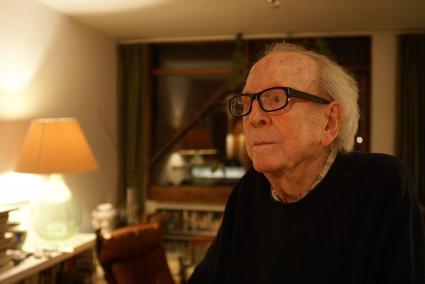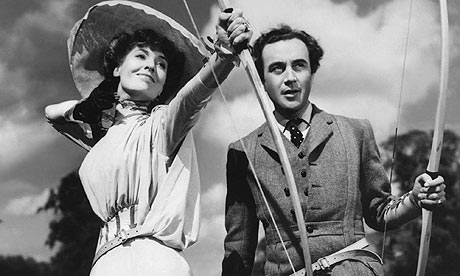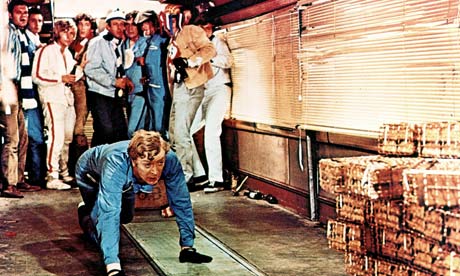When I paid tribute to Gilbert Taylor more than two-and-a-half years ago, I talked about how cinematographers don't always get the credit they deserve in their contribution towards the look of a film or the shooting style of a given director. In my reviews I've always tried to credit cinematographers when I can, and Douglas Slocombe's recent death, at the age of 103, grants me an excellent opportunity to do so again.
 When we look back at the classic Ealing comedies of the 1940s and 1950s, it's easy to define their essential features around the main actors and the types of characters they inhabit. Just as early Hammer horror films are indelibly identified with Peter Cushing and Sir Christopher Lee, so the heyday of Ealing will forever be associated with the likes of Alec Guinness and Dennis Price. But Slocombe, who made a name for himself working on some of the studio's best work, made every bit as big a contribution, helping to create the signature Ealing aesthetic. Anyone who has Kind Hearts and Coronets, The Man in the White Suit, The Lavender Hill Mob and The Titfield Thunderbolt on their CV is worthy of a great deal of respect.
When we look back at the classic Ealing comedies of the 1940s and 1950s, it's easy to define their essential features around the main actors and the types of characters they inhabit. Just as early Hammer horror films are indelibly identified with Peter Cushing and Sir Christopher Lee, so the heyday of Ealing will forever be associated with the likes of Alec Guinness and Dennis Price. But Slocombe, who made a name for himself working on some of the studio's best work, made every bit as big a contribution, helping to create the signature Ealing aesthetic. Anyone who has Kind Hearts and Coronets, The Man in the White Suit, The Lavender Hill Mob and The Titfield Thunderbolt on their CV is worthy of a great deal of respect.
 If Slocombe's career had died after Ealing closed its doors in the mid-1950s, that would have been a sufficient legacy for many people. But like Taylor, whose early career involved three stints with Roman Polanski, Slocombe kept innovating and brought his distinctive craft to a huge range of projects. In the 1960s he rubbed shoulders with Bryan Forbes on British New Wave classic The L-Shaped Room, captured Richard Attenborough on film in Guns at Batasi, and shot some memorable set-pieces on The Italian Job. In the 1970s he lensed films as variegated as the cult classic Rollerball, the musical Jesus Christ Superstar and the upmarket adaptation of The Great Gatsby starring Robert Redford. And in the 1980s, even as his eyesight rapidly deteriorated, he lent a warmly nostalic tone to the first three Indiana Jones films, helping to save Steven Spielberg's career in the process.
If Slocombe's career had died after Ealing closed its doors in the mid-1950s, that would have been a sufficient legacy for many people. But like Taylor, whose early career involved three stints with Roman Polanski, Slocombe kept innovating and brought his distinctive craft to a huge range of projects. In the 1960s he rubbed shoulders with Bryan Forbes on British New Wave classic The L-Shaped Room, captured Richard Attenborough on film in Guns at Batasi, and shot some memorable set-pieces on The Italian Job. In the 1970s he lensed films as variegated as the cult classic Rollerball, the musical Jesus Christ Superstar and the upmarket adaptation of The Great Gatsby starring Robert Redford. And in the 1980s, even as his eyesight rapidly deteriorated, he lent a warmly nostalic tone to the first three Indiana Jones films, helping to save Steven Spielberg's career in the process.
 Slocombe's impact on the film industry is well-documented, and he is as highly reverred as the likes of Wally Pfister, Roger Deacons, Jack Cardiff or the Cronenweth family. He was nominated for an Oscar three times (including Raiders of the Lost Ark), as well as winning three BAFTAs and being nominated for a further eight. Janusz Kaminski, himself an excellent cinematogether, sought to copy Slocombe's style for Indiana Jones and the Kingdom of the Crystal Skull to ensure that there was a feeling of continuity with the original trilogy. In short, anyone who can shoot a Bond film (Never Say Never Again) and an adaptation of Gilbert and Sullivan (The Pirates of Penzance) in the same year must have more than a modicum of talent, just as he had followed Polanski's heavily flawed The Fearless Vampire Killers with the celebrated period drama The Lion in Winter decades earlier.
Slocombe's impact on the film industry is well-documented, and he is as highly reverred as the likes of Wally Pfister, Roger Deacons, Jack Cardiff or the Cronenweth family. He was nominated for an Oscar three times (including Raiders of the Lost Ark), as well as winning three BAFTAs and being nominated for a further eight. Janusz Kaminski, himself an excellent cinematogether, sought to copy Slocombe's style for Indiana Jones and the Kingdom of the Crystal Skull to ensure that there was a feeling of continuity with the original trilogy. In short, anyone who can shoot a Bond film (Never Say Never Again) and an adaptation of Gilbert and Sullivan (The Pirates of Penzance) in the same year must have more than a modicum of talent, just as he had followed Polanski's heavily flawed The Fearless Vampire Killers with the celebrated period drama The Lion in Winter decades earlier.
 Any of the works I've mentioned - well, apart from Never Say Never Again - are a very fitting way to honour Slocombe's memory, with Kind Hearts and Coronets and Indiana Jones and the Last Crusade being my personal recommendations. His legacy is an extraordinary one which touched both British cinema and Hollywood, and his work should serve as a reminder that, whatever the merits of auteur theory, the director is not the only one behind the camera who deserves any credit. RIP.
Any of the works I've mentioned - well, apart from Never Say Never Again - are a very fitting way to honour Slocombe's memory, with Kind Hearts and Coronets and Indiana Jones and the Last Crusade being my personal recommendations. His legacy is an extraordinary one which touched both British cinema and Hollywood, and his work should serve as a reminder that, whatever the merits of auteur theory, the director is not the only one behind the camera who deserves any credit. RIP.
Daniel




Daniel

Comments
Post a Comment